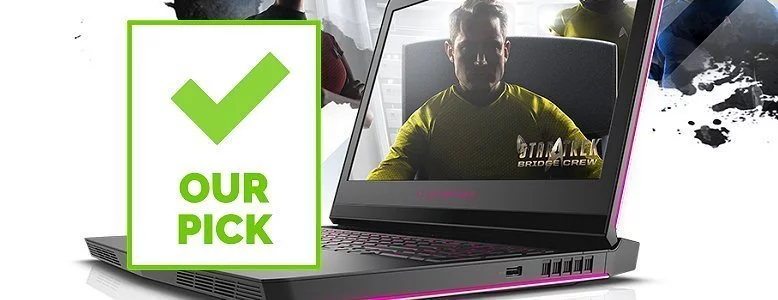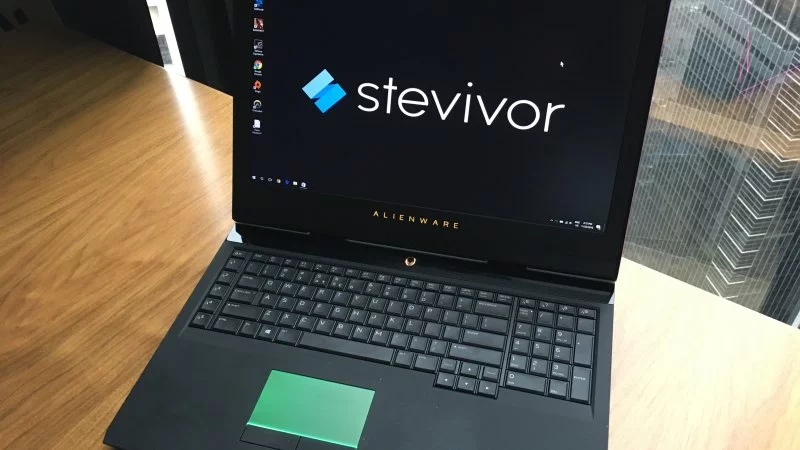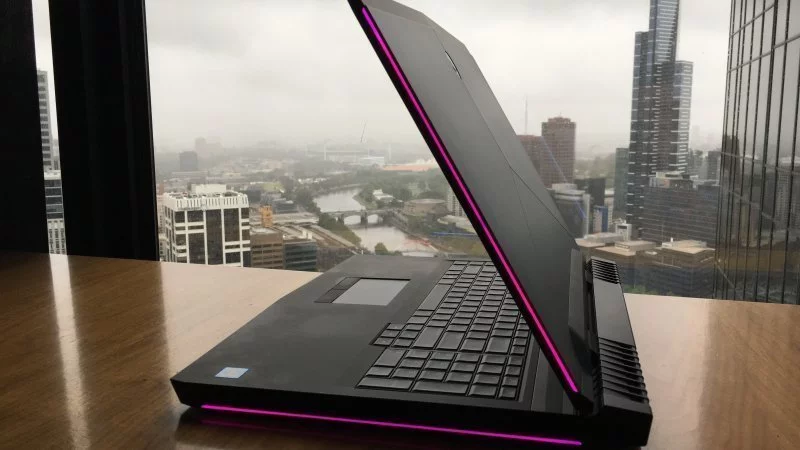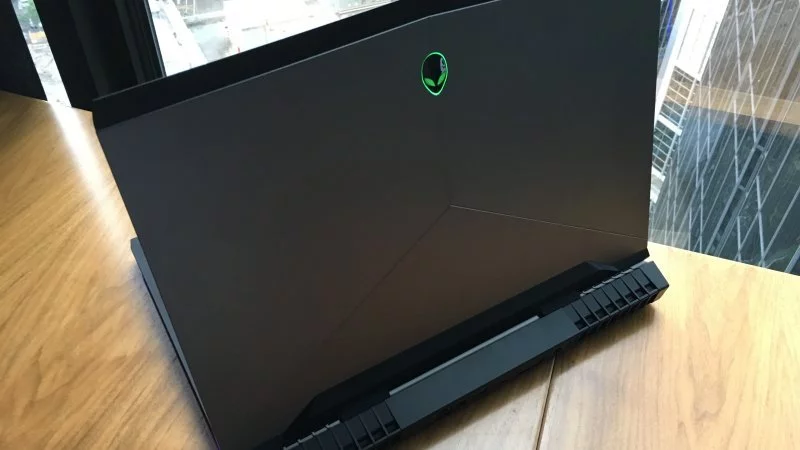A console guy through and through, I care more if my latest PC will run Adobe Creative Suite rather than Battlefield 1. That said, when an Alienware 17 comes across your desk, it’s hard to say no. Keep in mind that for the purposes of this review, I’m less concerned about processing and more about how the laptop feels.
To begin with, the new Alienware 17 feels damn heavy.
It easily weighs more than my Xbox One and PS4 combined, and is far too large to fit into my Crumpler laptop backpack. I’m not really concerned about that particular problem; if someone spots it under my arm as I’m carting it home, it could easily double as a blunt weapon. That is, if I could build up enough arm strength to even consider lugging it around.
The laptop’s matte gray finish contrasts nicely with its iconic, colour-changing Alien power button and backlighting, this time joined by (the optional) Tobii Eye Tracking’s deep red, HAL-like glowing interfaces. That fancy new bell (and or whistle) has been paired with an i7 2.60GHz processor, 16GB of RAM and an Nvidia GeForce GTX 1070 GPU with 8GB GDDR5 RAM to create something quite special.
At $3,598.99 AUD, I was flying the new flagship of Alienware’s laptop fleet, soaring high above cheaper options including a unit with 8GB of RAM and a GeForce GTX 1060 with 6GB GDDR5 RAM for $2,999 AUD, or one with 16GB RAM and a GTX 1060 with 6GB GDDR5 RAM for $3,199 AUD. The two highest tier models both come equipped with a 256GB solid state drive alongside a 1TB hard drive. In short, they’re all VR-ready; my model could handle 4K quite comfortably too.
I’ve played Battlefield 1 for hours upon end on my Xbox One, but I’ve never played with graphical settings jacked all the way up to Ultra. Light blooms, smoke pluming from the wreckage of a crashed tank – it was like I was playing inside a whole new world. That same feeling carried into Forza Horizon 3, an Xbox Play Anywhere title I picked up in mid-play from my good ol’ console. The familiar sights of Australia managed to look a more fluid and crisp than I thought possible. I’m not a big stickler for high frame rates, but I could get use to ‘em quite quickly.
Tobii Eye Tracking is crazy good and terrifying in equal measure. I didn’t have a full-blown game to test it on, but I was able to play through an in-built spaceship demo. It allowed me to use my eyeline to target incoming asteroids, and surprisingly, with great success. It was trippy to see the tracking work in-game, but even weirder to orbs representing my eyes dart around in the Windows 10 system tray. Equally creepy was having the laptop’s display brighten as it realised I was training my gaze back upon it. I don’t think eye tracking will replace targeting in something like Overwatch – especially if your native option is keyboard and mouse – but it was a neat little addition.
Whilst playing, I did notice the laptop’s fan getting louder as time progressed, but never distractingly so. All the while, intricate thermal ports kept air flowing and the laptop’s outer casing cool.
I’ve delved into PC gaming before, and with an Alienware laptop to boot, but quickly fell out of the running when I couldn’t be bothered keeping up with the platform’s ever-demanding upgrade cycle. This laptop avoids that issue somewhat with Alienware’s Graphics Amplifier, allowing for an upgradable graphics card to be plugged in when needed. I doubt that will be a concern for the better part of a year, mind you, but it’s nice to know the laptop won’t be obsolete as soon as you’ve paid it off.
Niceties aside, the biggest problem with the Alienware 17 is its weight and size. Despite the very nature of a laptop, this one isn’t that portable. I ended up sticking it on my office desk and leaving it there most of the time, and given that, was left pondering why I’d even bother with it over an actual PC tower. The latter is just as immobile, and gets rid of a potential Graphics Amplifier too – if it takes the same effort to replace a GPU in a tower as in an Amp, why bother?
The Alienware 17’s screen resolution also could push some towards a traditional tower setup. Completely acceptable for most gaming applications with a maximum on-screen resolution of 1920 x 1080, I relied on HDMI or Display Port outputs to larger resolution monitors to accomplish other tasks. You guessed it: Adobe CS-type tasks. If there’s a constant need to continually plug into external monitors, and the laptop’s too heavy to cart between work and home, why not just build a PC?
Not a tower, not a modular Alienware Alpha, this laptop sits somewhere in between. It’s a great rig in the here and now, more like a buildable tower, but that much power means it’s a bulky behemoth of a device. In a while, when you’ll need to consider either replacing the laptop itself or plugging in an Alienware Amp, it’s more akin to the Alpha, with cables jutting out to various peripherals.
In the end, a very specific type of gamer should consider the Alienware 17. It’s a pretty, juiced-up package, perfect for those who don’t want to build their own machine and would also like a slightly more portable version of a pre-built PC tower. Turns out, that’s closer to home than I expected. Just like it was hard to say no to the laptop as it arrived, I know it’s going to hard to say goodbye as well. Best start saving those pennies.
This article may contain affiliate links, meaning we could earn a small commission if you click-through and make a purchase. Stevivor is an independent outlet and our journalism is in no way influenced by any advertiser or commercial initiative.


























